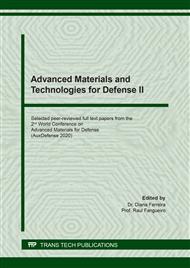[1]
A. Raza, Y. Li, J. Sheng, J. Yu, B. Ding, Protective Clothing Based on Electrospun Nanofibrous Membranes, in: B. Ding, J. Yu (Eds.), Electrospun Nanofibers for Energy and Environmental Applications, Springer, Berlin, Heidelberg, 2014, pp.355-369.
DOI: 10.1007/978-3-642-54160-5_14
Google Scholar
[2]
D.P. Ferreira, S.M. Costa, H.P. Felgueiras, R. Fangueiro, Smart and Sustainable Materials for Military Applications Based on Natural Fibres and Silver Nanoparticles, Key Eng. Mater. 812 (2019) 66–74.
DOI: 10.4028/www.scientific.net/kem.812.66
Google Scholar
[3]
A.-M. Croitoru, D. Ficai, A. Ficai, N. Mihailescu, E. Andronescu, C.F. Turculet, Nanostructured Fibers Containing Natural or Synthetic Bioactive Compounds in Wound Dressing Applications, Mater. (Basel, Switzerland). 13 (2020) 2407.
DOI: 10.3390/ma13102407
Google Scholar
[4]
M.A. Teixeira, M.C. Paiva, M.T.P. Amorim, A.H.P. Felgueiras, Electrospun Nanocomposites Containing Cellulose and Its Derivatives Modified with Specialized Biomolecules for an Enhanced Wound Healing., Nanomater. (Basel, Switzerland). 10 (2020) 557.
DOI: 10.3390/nano10030557
Google Scholar
[5]
H. Samadian, S. Zamiri, A. Ehterami, S. Farzamfar, A. Vaez, H. Khastar, M. Alam, A. Ai, H. Derakhshankhah, Z. Allahyari, A. Goodarzi, M. Salehi, Electrospun cellulose acetate/gelatin nanofibrous wound dressing containing berberine for diabetic foot ulcer healing: in vitro and in vivo studies, Sci. Rep. 10 (2020) 8312.
DOI: 10.1038/s41598-020-65268-7
Google Scholar
[6]
D.P. Ferreira, D.S. Conceicao, R.C. Calhelha, T. Sousa, R. Socoteanu, I.C.F.R. Ferreira, L.F. Vieira Ferreira, Porphyrin dye into biopolymeric chitosan films for localized photodynamic therapy of cancer, Carbohydr. Polym. 151 (2016) 160–171.
DOI: 10.1016/j.carbpol.2016.05.060
Google Scholar
[7]
N. Amiri, Z. Rozbeh, T. Afrough, S.A. Sajadi Tabassi, A. Moradi, J. Movaffagh, Optimization of Chitosan-Gelatin Nanofibers Production: Investigating the Effect of Solution Properties and Working Parameters on Fibers Diameter, Bionanoscience. 8 (2018) 778–789.
DOI: 10.1007/s12668-018-0540-5
Google Scholar
[8]
N. Cai, C. Li, C. Han, X. Luo, L. Shen, Y. Xue, F. Yu, Tailoring mechanical and antibacterial properties of chitosan/gelatin nanofiber membranes with Fe3O4 nanoparticles for potential wound dressing application, Appl. Surf. Sci. 369 (2016) 492–500.
DOI: 10.1016/j.apsusc.2016.02.053
Google Scholar
[9]
A.D. Juncos Bombin, N.J. Dunne, H.O. McCarthy, Electrospinning of natural polymers for the production of nanofibres for wound healing applications, Mater. Sci. Eng. C. 114 (2020) 110994.
DOI: 10.1016/j.msec.2020.110994
Google Scholar
[10]
H. Kargarzadeh, M. Mariano, J. Huang, N. Lin, I. Ahmad, A. Dufresne, S. Thomas, Recent developments on nanocellulose reinforced polymer nanocomposites: A review, Polymer (Guildf). 132 (2017) 368–393.
DOI: 10.1016/j.polymer.2017.09.043
Google Scholar
[11]
C. Zhou, R. Chu, R. Wu, Q. Wu, Electrospun Polyethylene Oxide / Cellulose Nanocrystal Composite Nanofibrous Mats with Homogeneous and Heterogeneous Microstructures, Biomacromolecules. 12 (2011) 2617–2625.
DOI: 10.1021/bm200401p
Google Scholar
[12]
I. Przybyłek, T.M. Karpiński, Antibacterial Properties of Propolis, Molecules. 24 (2019) (2047).
DOI: 10.3390/molecules24112047
Google Scholar
[13]
D.M. Ridolfi, A.P. Lemes, S. de Oliveira, G.Z. Justo, M. V Palladino, N. Durán, Electrospun poly(ethylene oxide)/chitosan nanofibers with cellulose nanocrystals as support for cell culture of 3T3 fibroblasts, Cellulose. 24 (2017) 3353–3365.
DOI: 10.1007/s10570-017-1362-2
Google Scholar
[14]
A. Hivechi, S.H. Bahrami, R.A. Siegel, Investigation of morphological, mechanical and biological properties of cellulose nanocrystal reinforced electrospun gelatin nanofibers, Int. J. Biol. Macromol. 124 (2019) 411–417.
DOI: 10.1016/j.ijbiomac.2018.11.214
Google Scholar
[15]
K. Jalaja, D. Naskar, S.C. Kundu, N.R. James, Potential of electrospun core–shell structured gelatin–chitosan nanofibers for biomedical applications, Carbohydr. Polym. 136 (2016) 1098–1107.
DOI: 10.1016/j.carbpol.2015.10.014
Google Scholar
[16]
P. Chen, L. Liu, J. Pan, J. Mei, C. Li, Y. Zheng, Biomimetic composite scaffold of hydroxyapatite/gelatin-chitosan core-shell nanofibers for bone tissue engineering, Mater. Sci. Eng. C. 97 (2019) 325–335.
DOI: 10.1016/j.msec.2018.12.027
Google Scholar
[17]
S. Habibi, K. Hajinasrollah, Electrospinning of Nanofibers Based on Chitosan/Gelatin Blend for Antibacterial Uses, Russ. J. Appl. Chem. 91 (2018) 877–881.
DOI: 10.1134/s1070427218050191
Google Scholar
[18]
H. Kargarzadeh, R. M. Sheltami, I. Ahmad, I. Abdullah, A. Dufresne, Cellulose nanocrystal: A promising toughening agent for unsaturated polyester nanocomposite, Polymer (Guildf). 56 (2015) 346–357.
DOI: 10.1016/j.polymer.2014.11.054
Google Scholar
[19]
H. Celebi, A. Kurt, Effects of processing on the properties of chitosan/cellulose nanocrystal films, Carbohydr. Polym. 133 (2015) 284–293.
DOI: 10.1016/j.carbpol.2015.07.007
Google Scholar
[20]
A. Hivechi, S.H. Bahrami, R.A. Siegel, Drug release and biodegradability of electrospun cellulose nanocrystal reinforced polycaprolactone, Mater. Sci. Eng. C. 94 (2019) 929–937.
DOI: 10.1016/j.msec.2018.10.037
Google Scholar
[21]
J. Liu, C.-K. Liu, E. Brown, Development and Characterization of Genipin Cross-linked Gelatin Based Composites Incorporated with Vegetable-Tanned Collagen Fiber (VCF), J. Am. Leather Chem. Assoc. 112 (2017) 410–419.
Google Scholar
[22]
X. Liu, T. Lin, Y. Gao, Z. Xu, C. Huang, G. Yao, L. Jiang, Y. Tang, X. Wang, Antimicrobial electrospun nanofibers of cellulose acetate and polyester urethane composite for wound dressing., J. Biomed. Mater. Res. B. Appl. Biomater. 100 (2012) 1556–1565.
DOI: 10.1002/jbm.b.32724
Google Scholar
[23]
A. Verlee, S. Mincke, C. V Stevens, Recent developments in antibacterial and antifungal chitosan and its derivatives, Carbohydr. Polym. 164 (2017) 268–283.
DOI: 10.1016/j.carbpol.2017.02.001
Google Scholar
[24]
P. Tyagi, R. Mathew, C. Opperman, H. Jameel, R. Gonzalez, L. Lucia, M. Hubbe, L. Pal, High-Strength Antibacterial Chitosan–Cellulose Nanocrystal Composite Tissue Paper, Langmuir. 35 (2019) 104–112.
DOI: 10.1021/acs.langmuir.8b02655
Google Scholar
[25]
J.M. Sforcin, Biological Properties and Therapeutic Applications of Propolis, Phytother. Res. 30 (2016) 894–905.
DOI: 10.1002/ptr.5605
Google Scholar


